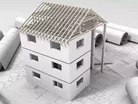How 3d printing is changing the global construction industry forever

The concept of 3D printing has been hovering around for some time now. The actual use of 3D printing and its adaption into the construction industry is now starting to become a reality. Architects and contractors around the world are beginning to build the first 3D residential structures including houses and apartment buildings.
What makes 3D printing different than current construction methods? The 3D printing is done using super-size printers which use a special concrete and composite mixture that is thicker than regular concrete, allowing it to be self-supporting as it sets, according to Via Technik. So 3D printed components do not have the same design constraints that may hinder current construction methods. In addition, curved concrete structures created through 3D printing can be hollow, using less material and creating space for building services inside the structural elements.
Not only could this revolutionize the construction industry, but the less expensive process could also affect housing affordability. Lower material usage and lower labor costs create a less expensive construction method which can in turn create lower-cost housing.
Chinese company Winsun has already claimed to have built 10 3D constructed houses in one day at a cost of just $5,000 per house. In addition to making housing more affordable, many architects also hope that 3D printing will increase their ability to customize homes and buildings. Earlier this year, Winsun took its 3D printing construction beyond single houses, building a five-story apartment building and an 11,840-square-foot villa. Winston used a large 3D printer that fabricates the building parts in large pieces at the company's facility. Winston then assembled the pieces on-site adding steel reinforcements and insulation.
According to an article from CNET, Winsun says the 3D process saves between 30 and 60 percent of construction waste, can reduce production times by 50 to 70 percent and reduce labor costs by 50 to 80 percent.
According to an article from Business Insider, 3D printers build structures layer by layer. However, USC Professor Behrokh Khoshnevis hopes to extend the fabrication process even further with contour crafting. "Contour Crafting technology has great potential for automating the construction of whole structures as well as sub-components."
The Business Insider article also says Khoshnevis hopes to develop a gigantic 3D printer that could print an entire house in a single run including the structure and all its conduits.The concept of 3D printing has been hovering around for some time now. The actual use of 3D printing and its adaption into the construction industry is now starting to become a reality. Architects and contractors around the world are beginning to build the first 3D residential structures including houses and apartment buildings.
What makes 3D printing different than current construction methods? The 3D printing is done using super-size printers which use a special concrete and composite mixture that is thicker than regular concrete, allowing it to be self-supporting as it sets, according to Via Technik. So 3D printed components do not have the same design constraints that may hinder current construction methods. In addition, curved concrete structures created through 3D printing can be hollow, using less material and creating space for building services inside the structural elements.
Not only could this revolutionize the construction industry, but the less expensive process could also affect housing affordability. Lower material usage and lower labor costs create a less expensive construction method which can in turn create lower-cost housing.
Chinese company Winsun has already claimed to have built 10 3D constructed houses in one day at a cost of just $5,000 per house. In addition to making housing more affordable, many architects also hope that 3D printing will increase their ability to customize homes and buildings. Earlier this year, Winsun took its 3D printing construction beyond single houses, building a five-story apartment building and an 11,840-square-foot villa. Winston used a large 3D printer that fabricates the building parts in large pieces at the company's facility. Winston then assembled the pieces on-site adding steel reinforcements and insulation.
According to an article from CNET, Winsun says the 3D process saves between 30 and 60 percent of construction waste, can reduce production times by 50 to 70 percent and reduce labor costs by 50 to 80 percent.
According to an article from Business Insider, 3D printers build structures layer by layer. However, USC Professor Behrokh Khoshnevis hopes to extend the fabrication process even further with contour crafting. "Contour Crafting technology has great potential for automating the construction of whole structures as well as sub-components."
The Business Insider article also says Khoshnevis hopes to develop a gigantic 3D printer that could print an entire house in a single run including the structure and all its conduits.
- Ora Developers & Orascom Construction sign US$103m agreementConstruction Projects
- WASP and Mario Cucinella Architects constructing 3D printed habitatBuilt Environment
- S-500: The 3D printer that AMT-SPETSAVIA says can print buildings 80m tallTechnology & AI
- US Army patents 3D printing solution for military-strength building constructionTechnology & AI



